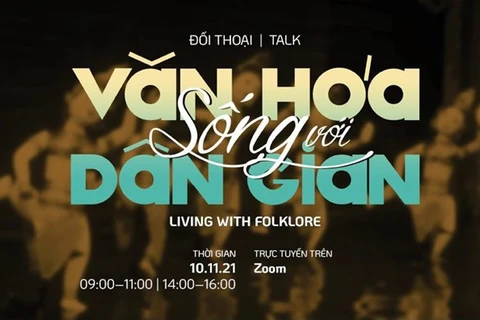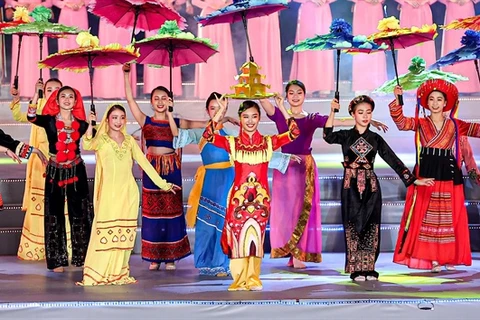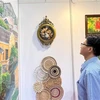 Photo: Digital platforms connect people and at the same time raise public awareness of cultural aspects of Vietnam that are not widely known (Photo courtesy of artist Nguyen The Son)
Photo: Digital platforms connect people and at the same time raise public awareness of cultural aspects of Vietnam that are not widely known (Photo courtesy of artist Nguyen The Son) Hanoi (VNA) - New investment models will be key to create opportunities for the development of Vietnam’s culture and creative industries in the international market.
In recent times, the digitalisation of cultural works in Vietnam has seen a positive change, especially since COVID-19 grounded the economy to a halt and put more people online. Prof. Julia Gaimster, head of Communication and Design at RMIT University, affirmed that it is a major achievement after the five-year implementation plan put in place for the Prime Minister’s cultural industry development strategy.
The increase of digital cultural content may further attract audiences at home and abroad, promoting images of Vietnamese contemporary culture to international friends around the world.
Setting up digital culture
In 2019, Hanoians were amazed by the ‘Into Thin Air’ art-in-public project brought by Manzi Art Space. A lacquer artwork on glass looked like it was moving thanks to augmented reality.
 A skylight in Cho Hom (Hom Market) resembles a floating pond in the air. It is an art project launched by Manzi Art Space. (Photo courtesy of artist Nguyen The Son)
A skylight in Cho Hom (Hom Market) resembles a floating pond in the air. It is an art project launched by Manzi Art Space. (Photo courtesy of artist Nguyen The Son) Dr Emma Duester from RMIT University said she believes that deeper Vietnamese art and culture will be viewed by foreign friends instead of just cliche images on traditional outfits, wars and tourist destinations found online.
Duester and her partner Michal Teague, who has obtained her master’s degree, have engaged in research on digital transformation of Vietnam’s culture and art. They overcame a lack of budget, human resources and technology to begin the research project.
Vietnam should give further thought to the digitalisation of archives to enable public access. This is one of the best methods for cultural conservation, in addition to strengthening related policies on cultural heritage and traditional culture conservation, Dr Duester said.
The expert went on to say that in the coming time, Vietnam will need a shared digital platform which is sustainable and easy to access so as to showcase influential artworks. With such a method, art lovers at home and abroad, together with cultural and educational experts and researchers can have access and become familiar with the works.
To tackle the challenges, she underlined the need to devise a ‘digital culture’ policy in Vietnam so as to ensure development in the cultural industries and raise public awareness of copyright and intellectual property in cyberspace in a systematic and sustainable manner.
To be more specific, Teague said that galleries, libraries, archives and museums in Vietnam need to define their suitable audiences and understand them in an attempt to effectively send their messages.
 From left: Prof Julia Gaimster, Dr Emma Duester and Michal Teague conduct group research on the digital transformation of Vietnam’s culture-art (Photo: RMIT)
From left: Prof Julia Gaimster, Dr Emma Duester and Michal Teague conduct group research on the digital transformation of Vietnam’s culture-art (Photo: RMIT)The expert emphasised that care must be taken to construct the virtual archives on culture and art of Vietnam so that educators and researchers can access quality cultural information on Vietnam in an authentic and systematic way.
Therefore, stakeholders need to join forces in related fields such as hotels, tourism, education, manufacturing and public transport to develop in-person and digital content platforms that attract audiences at home and abroad, the expert continued.
Investing in culture in a new way
From research experience in issues of globalisation, Dr Nguyen Thi Quy Phuong, former deputy head of a journalism and communication research institute, put forward five recommendations for Vietnam’s cultural industry development.
She suggested the State needs to classify businesses in the industry based on their specialisation and scale, and enable firms to access resources for product development.
 A scene in the movie ‘Bo gia’ (Dad, I'm Sorry), a product of Tran Thanh Town, enjoys humongous box office returns of 600 billion VND (25.64 million USD) (Photo: Tran Thanh town)
A scene in the movie ‘Bo gia’ (Dad, I'm Sorry), a product of Tran Thanh Town, enjoys humongous box office returns of 600 billion VND (25.64 million USD) (Photo: Tran Thanh town)To attract infrastructure investment for cultural industries, the Government can roll out land rental and preferential income tax rates so as to call for investment by the private sector.
The establishment of investment funds for cultural industries and relevant agencies should be taken into consideration, learning from experience of countries with thriving cultural industry models.
In an attempt to offset the Vietnamese people’s penchant to consume foreign cultural products, and at the same time ensure fairness and competitiveness, the Government should issue policies that motivate firms to uphold Vietnamese cultural phenomenon. They should attract ideas from across the globe and prevent the loss of talent in Vietnam’s cultural industries to firms from overseas./.























